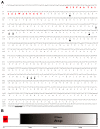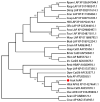Functional Role of AsAP in the Reproduction of Adelphocoris suturalis (Hemiptera: Miridae)
- PMID: 36005380
- PMCID: PMC9409435
- DOI: 10.3390/insects13080755
Functional Role of AsAP in the Reproduction of Adelphocoris suturalis (Hemiptera: Miridae)
Abstract
Adelphocoris suturalis Jakovlev (Hemiptera: Miridae) is an omnivorous agricultural pest that has severe economic impacts on a diverse range of agricultural crops. Although the targeted disruption of reproductive development among insects has been proposed as a novel control strategy for pest species, the current understanding of the physiology and molecular mechanisms of A. suturalis reproduction is very limited. In this study, we isolated a putative A. suturalisaspartic protease (AsAP) gene that is highly expressed in the fat body and ovaries of sexually mature females. The double-stranded RNA (dsRNA)-mediated knockdown of AsAP suppressed ovarian development and negatively impacted female fertility, which suggested that it plays an essential role in A. suturalis reproduction. The results of this study could help to expand our understanding of A. suturalis reproductive development and have the potential to facilitate the development of effective strategies for the better control of this pest species.
Keywords: Adelphocoris suturalis Jakovlev; RNAi; aspartic protease; ovarian development; reproduction.
Conflict of interest statement
The authors declare no conflict of interest.
Figures





Similar articles
-
Spray-induced and nanocarrier-delivered gene silencing system targeting juvenile hormone receptor components: potential application as fertility inhibitors for Adelphocoris suturalis management.Pest Manag Sci. 2024 Aug;80(8):3743-3751. doi: 10.1002/ps.8077. Epub 2024 Mar 27. Pest Manag Sci. 2024. PMID: 38469958
-
A transgenic strategy for controlling plant bugs (Adelphocoris suturalis) through expression of double-stranded RNA homologous to fatty acyl-coenzyme A reductase in cotton.New Phytol. 2017 Aug;215(3):1173-1185. doi: 10.1111/nph.14636. Epub 2017 Jun 13. New Phytol. 2017. PMID: 28608990
-
Comparative Analysis of Adelphocoris suturalis Jakovlev (Hemiptera: Miridae) Immune Responses to Fungal and Bacterial Pathogens.Front Physiol. 2021 Mar 18;12:646721. doi: 10.3389/fphys.2021.646721. eCollection 2021. Front Physiol. 2021. PMID: 33815150 Free PMC article.
-
Advances in the use of the RNA interference technique in Hemiptera.Insect Sci. 2013 Feb;20(1):31-9. doi: 10.1111/j.1744-7917.2012.01550.x. Epub 2012 Oct 5. Insect Sci. 2013. PMID: 23955823 Review.
-
Feasibility, limitation and possible solutions of RNAi-based technology for insect pest control.Insect Sci. 2013 Feb;20(1):15-30. doi: 10.1111/j.1744-7917.2012.01513.x. Epub 2012 Jun 12. Insect Sci. 2013. PMID: 23955822 Review.
Cited by
-
Integrated Omics Analysis Reveals Key Pathways in Cotton Defense against Mirid Bug (Adelphocoris suturalis Jakovlev) Feeding.Insects. 2024 Apr 8;15(4):254. doi: 10.3390/insects15040254. Insects. 2024. PMID: 38667384 Free PMC article.
-
The chromosome-scale reference genome of mirid bugs (Adelphocoris suturalis) genome provides insights into omnivory, insecticide resistance, and survival adaptation.BMC Biol. 2023 Sep 19;21(1):195. doi: 10.1186/s12915-023-01666-3. BMC Biol. 2023. PMID: 37726763 Free PMC article.
References
-
- Huis A.V. The Global Impact of Insects. Wageningen UR; Wageningen, The Netherlands: 2014.
Grants and funding
LinkOut - more resources
Full Text Sources

